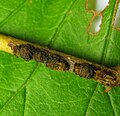Viburnum leaf beetle
| Viburnum leaf beetle | |
|---|---|

| |
| Dorsal view | |

| |
| Lateral view | |
| Scientific classification | |
| Kingdom: | Animalia |
| Phylum: | Arthropoda |
| Class: | Insecta |
| Order: | Coleoptera |
| Family: | Chrysomelidae |
| Subfamily: | Galerucinae |
| Tribe: | Galerucini |
| Genus: | Pyrrhalta |
| Species: | P. viburni
|
| Binomial name | |
| Pyrrhalta viburni (Paykull, 1799)
| |
Pyrrhalta viburni is a species of leaf beetle native to Europe and Asia, commonly known as the viburnum leaf beetle. It was first detected in North America in 1947 in Ontario, Canada. However, specimens had been collected in Annapolis Royal, Nova Scotia in 1924. In 1996 it was discovered in a park in New York, where native plantings of arrowwood (Viburnum dentatum complex) were found to be heavily damaged by larval feeding.[1] The UK-based Royal Horticultural Society stated that its members reported Pyrrhalta viburni as the "number one pest species" in 2010.[2][3] Female beetles burrow into viburnum terminal twigs and create 'spaces' in pith tissue. Then they lay eggs in clusters and cover them with frass. Eggs overwinter in these cavities where they are protected from water loss and predation.[4]
The spined soldier bug, Podisus maculiventris is used and developed as a biological control agent against the beetle.[1]
Life cycle[]
Viburnum leaf beetles go through one new generation of offspring per year. Eggs are laid in the winter and they hatch in mid-May. After they hatch, the larva feed and grow successively bigger through different molting stages. Ultimately, they pupate in the soil and emerge as adults in late June or early July.
Females tend to lay eggs at the end of twigs and leaves. After chewing a hole in the step, the female will lay 5-6 eggs along the underside of the twig.[5]

Egg cases

Eggs

Larva

Leaf damage

Mating
References[]
- ^ a b Desurmont, G.; Weston, P. A. (2008). "Predation by Podisus maculiventris (Say) (Hemiptera: Pentatomidae) on Viburnum Leaf Beetle, Pyrrhalta viburni (Paykull) (Coleoptera: Chrysomelidae), Under Laboratory and Field Conditions". Environmental Entomology. 37 (5): 1241–1251. doi:10.1093/ee/37.5.1241. ISSN 0046-225X. PMID 19036203.
- ^ "Top 10 pests". Wisley, England: Royal Horticultural Society. 19 January 2011. Archived from the original on 9 October 2013. Retrieved 4 September 2014.
- ^ "Viburnum beetle". Wisley, England: Royal Horticultural Society. 2014. Retrieved 4 September 2014.
- ^ "How to win the battle against the viburnum beetle". The Daily Telegraph. Retrieved 2015-05-02.
- ^ Connolly, Alaine (2021-06-12). "Viburnum Leaf Beetles: Comprehensive Guide". The Green Pinky. Retrieved 2021-08-02.
External links[]
- Viburnum leaf beetle on the UF / IFAS Featured Creatures Web site
- [1] PEST ALERT: Viburnum Leaf Beetle
- [2] Penn State College of Agriculture
- Gardeners' World
- Bugguide.net. Species Pyrrhalta viburni - Viburnum Leaf Beetle
- Galerucinae
- Beetles of Europe
- Beetles of Asia
- Beetles described in 1799




